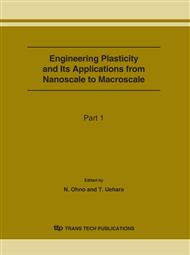p.645
p.649
p.655
p.659
p.665
p.671
p.677
p.683
p.689
Evaluation of Hole Flangeability of Steel Sheet with Respect to the Hole Processing Condition
Abstract:
This paper is concerned with hole flangeability of steel sheet, which is evaluated by experiment and finite element analysis with respect to the hole processing condition. The hole flangeability of a material as a forming limit needs to be verified to predict and prevent the undesirable fracture during a flanging process. Hole expanding tests are carried out to identify the effect of hole processing conditions on the hole expanding ratio (HER), which is an indicator of the hole flangeability. Specimens with two different hole conditions are prepared: one is produced with punching process; and the other is reamed after punching to get smoother hole surface. Experimental results show that the facture mechanism and the HER are quite different with respect to the hole conditions. Thorough investigation of those effects is carried out with tensile tests of a specimen with notches. From the experiments, the fracture strain is obtained with different hole conditions and is used to determine the material constants of a new proposed ductile fracture criterion which is applied to finite element analyses of the hole flanging process for prediction of the HER. The experimental results are confirmed and reevaluated by the finite element analysis with the ductile fracture criterion.
Info:
Periodical:
Pages:
665-670
Citation:
Online since:
June 2007
Authors:
Price:
Сopyright:
© 2007 Trans Tech Publications Ltd. All Rights Reserved
Share:
Citation:


